HENRY TERRELL, News Editor
Drill bit costs, although not insignificant, are a small part of total well expense. The largest factor, by far, in escalating well drilling costs is the number of days spent. The newer drill bit designs all have the same ultimate goals—durability, efficiency, speed and delivery of a high-quality wellbore. Days saved equal money saved.
The keyword in modern drilling is control. As “unconventional” drilling becomes conventional, shale oil and gas reservoirs demand greater, more subtle control. With shale, PDC is the bit of choice, and while roller-cone technology is still valued for faster rates of penetration (ROP) and lower cost-per-foot, fixed-cutter bits now fulfill around 80% of hydrocarbon drilling. Hybrid drill bits, which have characteristics of both types, are finding a larger niche.
While other factors affect drilling performance and economics, including drilling fluids and good seismic data, the drill bit is the one part of the equation that makes the biggest difference. Tailor-made bits designed for a specific drilling application are becoming more common, and designers are becoming more adept at customization with shorter turnaround times.
Longer-term, operators are thinking more and more about the well in its entirety, seeking an engineered drilling system instead of a menagerie of components bolted together. More often, we begin to see a truly wholistic system, designed from the surface down to the bit itself.
BAKER HUGHES
The primary goal of new drill bit technology is to improve performance while minimizing drilling and completion costs, and reducing nonproductive time. The Hughes Christensen Talon platform of PDC bits was designed to provide better directional control, longer run life, improved rates of penetration (ROP) and enhanced durability, Fig. 1.
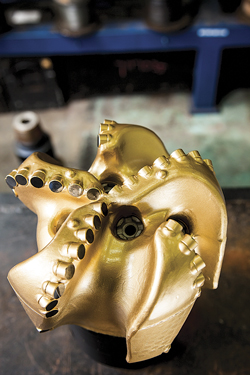 |
| Fig. 1. The Hughes Christensen Talon 3D high-efficiency, vector-accurate PDC bit features a one-piece steel frame for increased hydraulic and mechanical efficiency, while its short bit-to-bend dimension delivers better buildup rate with longer life. |
|
According to Product Line Manager Matt Meiners, “Through a combination of enhanced hydraulic, mechanical and cutter efficiencies, these PDC bits improve drilling performance and let customers drill faster and farther while reducing days-on-well and minimizing costs and risks.”
Talon bits aim to deliver consistent performance by optimizing hydraulic energy at the bit to ensure maximum cuttings evacuation. Advanced diamond technology helps improve cutting efficiency and increases ROP and durability by helping cutters stay sharper longer. The bits use a stable, efficient and durable design to deliver improved performance and mechanical efficiency.
Every Talon bit begins with the Baker Hughes DART drilling application review process, a collaborative process that combines new and existing technology, extensive knowledge and innovative designs to try and find exactly the right drill bit for a specific application.
The Talon platform consists of the Talon bit, the Talon 3D bit, and the AutoTrak Curve system bit. All Talon bits include Baker Hughes StaySharp premium PDC cutters with diamond technology and patented polished faces.
The Talon high-efficiency PDC bit is suitable for first-bit-under-the-surface applications, intermediate, vertical and near-vertical drilling, as well as difficult-to-drill and abrasive formations. The bits feature a new gauge pad that uses tungsten carbide and thermally stable polycrystalline diamond materials to protect gauge pads and keep bits in gauge longer. Their short shank decreases make-up length for higher levels of control in conventional directional drilling and increased bit side force on rotary steerable systems.
For unconventional gas applications, including shale plays and conventional directional drilling, Talon 3D high-efficiency vector-accurate bits feature a one-piece steel body with short a bit-to-bend dimension. They provide improved hydraulic efficiency, greater buildup aggressiveness and longer life, often allowing curves and lateral sections to be drilled in a single run.
Every Talon 3D bit also includes the Baker Hughes StayTough hardfacing, which combines advanced materials with precise oxyacetylene welding procedures to impart maximum levels of durability. The combination reduces bit erosion in most any drilling environment, protecting the bit body from damaging rock formations and debris while improving wear resistance.
Talon bits are also fully compatible with the Baker Hughes AutoTrak Curve rotary steerable drilling system.
NATIONAL OILWELL VARCO
Drilling through hard, interbedded lithologies represents a severe challenge for drill bits. NOV Downhole’s new HeliosImpact cutters and FuseTek drill bits have been proven to drill longer and faster, through a wide range of lithologies, improving efficiency in extreme drilling environments.
Typically, a new bit will drill fast at first, but gradually slow down over the interval, as the cutters dull from abrasive wear, thermal breakdown or impact. Recently launched following successful field trials worldwide, the new HeliosImpact cutters have been engineered specifically to withstand the edge chipping experienced in tough interbedded applications. In laboratory tests, they showed a 45% improvement in impact resistance compared to conventional premium cutters.
The FuseTek hybrid technology drill bits offer the ROP of a PDC bit while maintaining the durability of a diamond-impregnated bit. This fusion of proven technologies has been demonstrated to drill longer without the need to change bit types, and can be utilized on rotary and downhole motors without the need for a turbine. It features a cutting structure that is optimally positioned in the critical wear areas of the bit, and continuously engages the formation, going from soft to hard and back. A secondary row of cutting elements on the blades allows the bit to deliver up to twice the cutting density of single-row models, enhancing durability without sacrificing aggressivity.
Field runs with FuseTek drill bits have shown superior cutting structure endurance in harsh rock applications in different areas worldwide. Similarly, HeliosImpact cutters have been proven to retain their cutting edge longer, and complete the interval with a faster overall ROP.
In Ecuador, a FuseTek bit fitted with HeliosImpact cutters was proposed to drill an intrusive section where traditionally a number of insert bits were used. The 8½-in. FT813 achieved a field record, drilling the complete intrusive interval of 738 ft, plus 312 ft of non-intrusive rock, at an ROP of 29 ft/hr. This replaced three insert bits that averaged 12 ft/hr, saving four days of drilling time.
In Nacogdoches, Texas, a 9.875-in. 616 design was run with HeliosImpact cutters through the Travis Peak formation, known for causing cutter spalling, chipping and breakage. While competitive performance was reported, the real benefits became apparent when, after 10,700 ft of drilling, the cutters suffered only minimal damage (Fig. 2) when compared with direct Helios offset cutters.
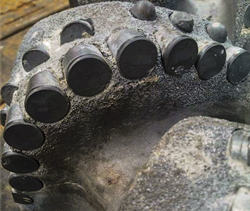 |
| Fig. 2. A FuseTek bit fitted with HeliosImpact cutters drilled 10,700 ft with only minimal wear. |
|
In the U.S., 6⅛-in. FT613 was run in Kansas for a major operator in a 2,000-ft lateral section, where high chert content was encountered at different intervals.
SMITH BITS
Since the ONYX II premium PDC cutters were introduced last year by Smith Bits, a Schlumberger company, the company is seeing successful bitruns in North America and around the world. Robert Ford, Product Commercialization Manager, Smith Bits, told World Oil, “We have talked to customers about the applications, identifying areas where the bit was dulling out prematurely, analyzing excessive cutter wear. We identified their applications and tried to understand their drilling objectives. By doing this, we are able to identify the right locations to position ONYX II cutters into those particular bits.”
One example he cited is an 8¾-in. vertical section in the Williston basin. This very long section, 5,000–7,000 ft, would have been drilled, historically, with a six-blade-style bit with conventional ONYX cutters. “With the introduction of ONYX II, we were not only able to bring better cutter technology, we were able to reduce the wear on the bit, and were able to change the bit design,” said Ford. “We went to a five-blade design. It was a combination of a better cutter for better wear resistance, as well as a new design to improve ROP. Moving from a six to a five-blade design, with new cutter technology, improved performance in the application, and so it has become the standard for us in that particular application.”
Last year, Schlumberger introduced the PowerDrive Archer, high-build-rate rotary steerable system (RSS). The system is capable of drilling complex 3D trajectories and openhole side tracks from any inclination, and can also drill vertical and horizontal sections, in one run, without having to change the bottomhole assembly (BHA). The system’s hybrid steering combines both push-the-bit and point-the-bit technologies, allowing the tool to navigate in a way that was previously possible only with a downhole motor, and to deliver high build rates for any deviation from vertical.
The PowerDrive Archer RSS has been combined with new improvements in the SHARC high-abrasion-resistance PDC drillbits to significantly reduce rig time. SHARC bits are designed for superior performance in highly abrasive formations.
Optimizing the cutting structure yields a very stable bit that limits cutter wear and maximizes footage, without sacrificing rate of penetration (ROP). SHARC bits have two rows of cutters per blade, which enhances durability in the nose and shoulder areas, Fig. 3. The two rows of cutters are oriented to maintain hydraulic cleaning and cooling.
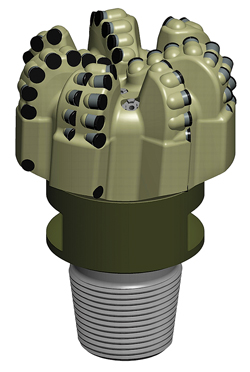 |
| Fig. 3. The SHARC MDSi716 8½-in drill bit with two rows of cutters in the critical shoulder area provides maximum durability in abrasive formations. Illustration courtesy of Schlumberger. |
|
The Spear product line, the shale-optimized steel-body PDC, was designed exclusively for unconventional shale plays. Launched two years ago, the Spear bits have had more than 5,000 runs across the world, including North America, Argentina, China and Poland. Spear bits were specifically designed to improve shale play economics by efficiently drilling both curves and long lateral hole sections, while minimizing bit balling, thus improving ROP, and enhancing directional control.
The Spear drill bits minimize buildup of cuttings in front of the bit and improve ROP by utilizing directional mud flow, which cleans debris so that a sharp cutting edge always meets rock. The bullet-shaped body streamlines the bit, making it easier for cuttings to sweep around the body. Body diameter is smaller, increasing the distance between the borehole and the bit body in the junk slot, improving the ability of cuttings to pass through the slots. Smaller cutters are used to improve directional control, without affecting ROP.
“Over the past year, we have worked upon improving the original Spear design, and right now we’re in the process of releasing the next generation of the Spear drill bit,” said Ford. “We’ve actively introduced these into North American shale plays, especially the Eagle Ford and we’ve had success improving ROP and control with wellbore trajectory,” Fig. 4.
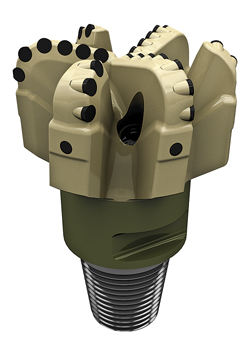 |
| Fig. 4. The next-generation Spear shale-optimized steel-body PDC drill bit is tailored for unconventional shale plays. (Illustration courtesy of Schlumberger) |
|
Every oil field target has different geological features that create unique drilling situations. To optimize drilling, the operator must choose drill bits with optimum characteristics to deal with expected lithology. Drill bits are an integral part of the drilling system, along with drillpipe, MWD tools, stabilizers, reamers and RSS (or downhole motors). Bits can be custom-designed for a given situation, providing maximum ROP and stability.
“What we are going to see more of are true, engineered drilling systems—optimizing the bit with the entire BHA— to deliver much better performance,” said Ford. “We are going to see more of these systems, coupled with improvements in individual components. You can improve a bit, but does the system affect wellbore tortuosity, or cause micro doglegs in the wellbore? If you design a system that can deliver wellbore quality with trajectory control, you can improve well construction effiency such as running casing with no problems, improve borhole quality and critically deliver better reservoir productivity.
“Our ultimate goal is to deliver one bit run per section. With this focus and utilizing IDEAS integrated brillbit design platform, application-specific bit design is really what is driving us moving forward. Understand the requirements of the operator, and from that develop a bespoke bit design solution to help lower costs.”
VAREL
Varel International has built the world’s largest steel-tooth roller cone bit, providing a single-bit solution for tophole drilling that previously involved drilling a pilot hole and then re-drilling with a hole-opening assembly, Fig. 5. More than 22% larger in diameter than any previous roller cone bit, the 44-in. MT L111 (IADC:111) design was requested specifically by a major Middle Eastern operator to accommodate a revised casing plan that would afford greater access to newly discovered reservoir potential in deep gas offshore wells.
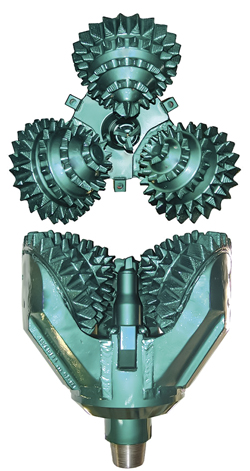 |
| Fig. 5. The Varel 44-in. MT bit—the world’s largest steel-tooth roller cone bit—was designed and manufactured in just eight months. |
|
After exploration wells revealed evidence of the potential of the reservoirs, field development began with a plan to drill the reservoirs in 12-in. hole, which required revising the standard casing program for greater depth and strength. The 44-in. MT bit was introduced to drill to greater depths for the revised casing program. Varel International designed and manufactured the MT L111—the world’s largest steel-tooth roller cone bit—in eight months.
The ultra-large-diameter bit features an advanced cutting structure with optimized row placement, tooth spacing and cutter geometry for increased drilling efficiency. These attributes also work to minimize tooth wear and prevent cutter tracking in a wide variety of formations and conditions. Specifically, the high-extension, balling-resistant cutting structure features forged teeth and full-cap premium tooth hardmetal for high penetration rates and long life in the soft, abrasive formations found in the target application.
Initially, three MT L111 bits were run simultaneously in offshore projects, meeting all targets and objectives. The primary objective was to run the 44-in. design and drill the upper hole at about a 1,270-ft depth. The second was to assess the full potential of the bit in the field, including cutting the cost per foot of using a standard 34-in. bit plus hole opening.
The MT bits were run in the hole on three wells, and they successfully drilled and enlarged the hole from 22 in. to 44 in. from seabed to casing point. Although they initially planned to drill two sections equivalent to around 500 ft, the bits twice drilled more than 800 ft during the initial runs, mostly in shale and claystone with some Argillaceous limestone.
To date, ten 44-in. MT L111 bits have been used in the field, both for drilling new hole (longest run at 165 ft and 55 fph); and for hole opening (longest run of 898 ft).
The new Voyager line of PDC bit is designed for smooth torque, advanced directional control, excellent wellbore quality and dynamic stability, Fig. 6. The series concept stems from a deeper understanding of bit and cutting structure design, which reveals that controlling variation in torque makes it possible to engineer the bit’s behavior signature in specific ways. The behavior signature is a unique description of how a specific bit design will react in various applications, based on factors including rock type and hardness, as well as type of drive system.
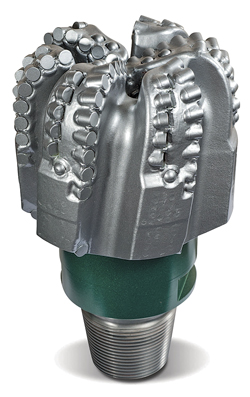 |
| Fig. 6. Voyager bits, from Varel, employ shock-reduction features that act as torque limiters and optimize depth of cut for smooth torque control. |
|
Voyager bits have shock reduction features, which act as torque limiters and help optimize depth of cut for smooth torque control. This works in combination with three gauge configuration options to affect specific directional behaviors.
The (G1) Stepped Gauge is designed for use with conventional rotary, steerable PDM, and ‘Point-the-Bit’ RSS drilling assemblies, providing flexibility for a range of directional drilling applications.
For all Push RSS systems, the Undercut G2 Semi-active gauge pad selection is based on formation hardness and directional requirements. In addition, the undercut can be varied, based on mud type, for use with specific drive systems.
The (G3) Active Gauge for push-the-bit systems is designed principally for high DLS/3D sidetracking drilling applications, where a very high level of side-cutting action is the prime requirement. The (G3) gauge provides an extremely aggressive cutting action to optimize lateral drillability, generating higher levels of reactive torque at the bit/rock interface. The very short gauge length, with increased point loading of gauge pad cutters that have engineered exposure, provides the aggressive lateral cutting action.
Advanced modeling determines which gauge design optimizes the ability to drill the required build-up rate, to reduce vibration and stick slip, and to improve steerability and limit walking, which is common with an adjustable gauge stabilizer that controls only inclination and not azimuth.
Varel’s focus on matching gauge configuration with drive system makes it possible to develop solutions for all service providers’ tools. Voyager bits are seamlessly compatible with multiple systems, including the new drive systems that produce massive amounts of torque to drill faster. 
|









